Los Alamos to Boston (September 1994)
by Philip Greenspun
Home : Travel : Footsteps : One Section
Friday, September 23, 1994
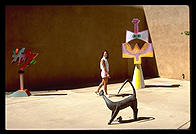 I was just getting to really like Los Alamos. I'd met the town
intellectuals and had two or three dinner dates a week and a lunch
date every day if I could tear myself away from my beloved Macintosh
Common Lisp. Weekends with Susie and Stephen in Santa Fe, with its
string of Friday night art gallery openings and super deluxe art
market kept me sane. However, it was getting cold in my tent and I
decided that LANL was a better place to finish a computer science PhD
thesis than to start one. I started driving back towards MIT.
I was just getting to really like Los Alamos. I'd met the town
intellectuals and had two or three dinner dates a week and a lunch
date every day if I could tear myself away from my beloved Macintosh
Common Lisp. Weekends with Susie and Stephen in Santa Fe, with its
string of Friday night art gallery openings and super deluxe art
market kept me sane. However, it was getting cold in my tent and I
decided that LANL was a better place to finish a computer science PhD
thesis than to start one. I started driving back towards MIT.
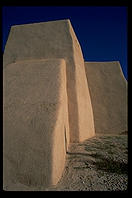 New Mexico beckoned me back even as I drove out into Colorado. A
cloudless sky overhead and the surreal autumn light made Taos and the
beautiful valley of Arroyo Honda shimmer. I finally understood why
the place attracted so many painters. New Mexicans describe their
state as "Land of Enchantment" or "Land of the Flea and Home of the
Plague" depending upon mood, but I'd concluded for sure that this was
the land of the cracked windshield. I couldn't believe that I'd
survived both the Alaska Highway and a summer in New Mexico with my
windshield intact.
New Mexico beckoned me back even as I drove out into Colorado. A
cloudless sky overhead and the surreal autumn light made Taos and the
beautiful valley of Arroyo Honda shimmer. I finally understood why
the place attracted so many painters. New Mexicans describe their
state as "Land of Enchantment" or "Land of the Flea and Home of the
Plague" depending upon mood, but I'd concluded for sure that this was
the land of the cracked windshield. I couldn't believe that I'd
survived both the Alaska Highway and a summer in New Mexico with my
windshield intact.
Fifteen miles short of the Colorado border, on a smooth highway with
no evidence pebbles, a pickup truck coming the other way kicked up
something that put a dime-sized crack right in front of my eyes.
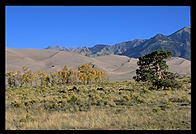 It was 8pm and almost pitch dark when I got to the campground at Great
Sand Dune National Monument. A ranger narrated a half hour slide show
on Colorado wildflowers, all of which were long dead, for a
miscellaneous collection of Swiss-Germans and Coloradans. Her
presentation was devoid of the usual National Park Service New Age
philosophy except at the end: "next time you look at a wildflower,
feel the wonder." Wind and cold was about to penetrate my Gore-Tex
Thinsulate parka so I was happy to pitch my tent and get into the
sleeping bag. The wind was so strong, though, that it would blow part
of the tent in on my head every now and then. Ear plugs were
essential to keep the howling wind noise out.
It was 8pm and almost pitch dark when I got to the campground at Great
Sand Dune National Monument. A ranger narrated a half hour slide show
on Colorado wildflowers, all of which were long dead, for a
miscellaneous collection of Swiss-Germans and Coloradans. Her
presentation was devoid of the usual National Park Service New Age
philosophy except at the end: "next time you look at a wildflower,
feel the wonder." Wind and cold was about to penetrate my Gore-Tex
Thinsulate parka so I was happy to pitch my tent and get into the
sleeping bag. The wind was so strong, though, that it would blow part
of the tent in on my head every now and then. Ear plugs were
essential to keep the howling wind noise out.
Saturday, September 24, 1994
 I managed to push myself out of bed at 6:45 by reminding myself that I
hadn't come all the way here to miss the shadows on the sand dunes.
The scenery was perfect.
A field of Colorado fall color, mostly
yellow and maroon, backed by a 700 foot high sand dune over which
towered the sharp peaks of the Sangre de Cristos. I hiked out onto
the dunes for a bunch of footprint-free shadow-filled shots but felt
no desire to climb all the way to the top through the viscous sand.
I managed to push myself out of bed at 6:45 by reminding myself that I
hadn't come all the way here to miss the shadows on the sand dunes.
The scenery was perfect.
A field of Colorado fall color, mostly
yellow and maroon, backed by a 700 foot high sand dune over which
towered the sharp peaks of the Sangre de Cristos. I hiked out onto
the dunes for a bunch of footprint-free shadow-filled shots but felt
no desire to climb all the way to the top through the viscous sand.
Air conditioning, telephones, satellite TV, and Internet have
ameliorated some of the hardships of life in the real West, but
breakfast at the Oasis cafe just outside the park taught me that it is
still a different world. My waitress had been a passenger in a car
when a rock came through the windshield going 110 mph.
"We're still looking for the truck that kicked up the rock," her
father noted. "She might have been killed if she hadn't had her head
turned sideways."
As it was, she still had some nasty scars and hadn't been able to
start at Arizona State University as planned.
"You can be decapitated by a Kleenex box in the back seat if you stop
short," noted the waitress's young grandmother. We appeared
skeptical. "It's true. If you're going 60 mph, a Kleenex box can
take you head right off."
"If I had to choose between a rock and a Kleenex box, I'd take the
Kleenex," I offered.
"Me too," said the waitress.
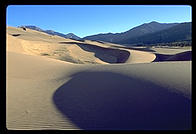
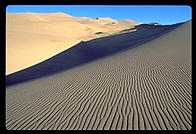
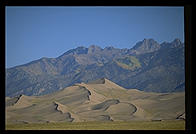
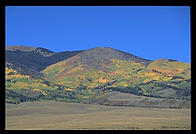 I drove through open range in a flat valley north towards US 285, a
scenic route that follows the spine of the Rockies for a thousand
miles or so. I stopped to check out an alligator and fish farm before
pressing on to Salida. Like every Western town, there is the
inevitable strip of WalMart, fast foods, and supermarket, but Salida
has a vital brick downtown as well. I learned that the town was home
to one of America's nicest mountain bike rides, the Monarch Crest.
You take a shuttle bus up to 11,000' for $10, then climb just 1000'
more along the Continental Divide, then ride mostly downhill for the
rest of the 35 mile trip. That's my kind of biking and it broke my
heart not to be able to stay another day in town and do it.
I drove through open range in a flat valley north towards US 285, a
scenic route that follows the spine of the Rockies for a thousand
miles or so. I stopped to check out an alligator and fish farm before
pressing on to Salida. Like every Western town, there is the
inevitable strip of WalMart, fast foods, and supermarket, but Salida
has a vital brick downtown as well. I learned that the town was home
to one of America's nicest mountain bike rides, the Monarch Crest.
You take a shuttle bus up to 11,000' for $10, then climb just 1000'
more along the Continental Divide, then ride mostly downhill for the
rest of the 35 mile trip. That's my kind of biking and it broke my
heart not to be able to stay another day in town and do it.
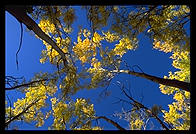 I ate lunch at the First Street Cafe with Norm, a 5th-generation
German-American who grew up in New Jersey but joined the 10th Mountain
Division and trained at Fort Hale, north of Leadville, Colorado.
I ate lunch at the First Street Cafe with Norm, a 5th-generation
German-American who grew up in New Jersey but joined the 10th Mountain
Division and trained at Fort Hale, north of Leadville, Colorado.
"It was all volunteer and great skiing, but camping in minus 40 degree weather wasn't much fun."
They fought the Germans in the mountains of Italy, 990 of the 15,000 men falling to enemy artillery.
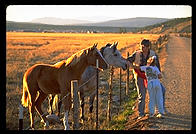 "I was on a ship near the Azores en route to retraining for the
invasion of Japan when we got news about the Hiroshima bomb. I didn't
believe it. There was a guy who'd been a DJ before the war who put
together a daily news show for men on the ship from what he got over
the ship's radio. He was a renowned prankster and none of us who knew
him believed the atomic bomb story. When we found out it was true, we
were walking on air for days."
"I was on a ship near the Azores en route to retraining for the
invasion of Japan when we got news about the Hiroshima bomb. I didn't
believe it. There was a guy who'd been a DJ before the war who put
together a daily news show for men on the ship from what he got over
the ship's radio. He was a renowned prankster and none of us who knew
him believed the atomic bomb story. When we found out it was true, we
were walking on air for days."
Not everyone in Salida is so thrilled with the work of Los Alamos,
however. A downtown storefront is the studio and home of the
artist/agitator Dr. Doom. He campaigns against Republicans, nuclear
arms, and a litany of other right-wing ills by driving around the West
in placard-covered vehicles and dumping drums labeled "nuclear waste"
on roadsides. The election of Bill Clinton has taken a lot of the
wind out of his sails even if nothing substantive has been
accomplished on any liberal front.
After a shower and dip in the Salida hot springs, I spun up through
yellow Aspens, green pines, horse pastures, and bald high passes to the southern
entrance of Rocky Mountain National Park.
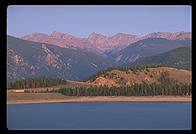
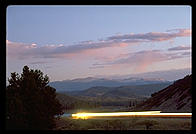
Sunday, September 25, 1994
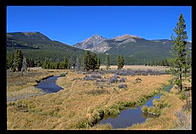 The Shadowcliff youth hostel takes the "hostile" out of hostel with a
glorious view over Shadow Mountain Lake to at least five mountain
ranges. I spent the day hunting great photographs of Aspens,
waterfalls, and the Rockies, but somehow never hit my
photographic stride, perhaps partly due to spirit-lifting but photographically
boring cloudless blue skies.
The Shadowcliff youth hostel takes the "hostile" out of hostel with a
glorious view over Shadow Mountain Lake to at least five mountain
ranges. I spent the day hunting great photographs of Aspens,
waterfalls, and the Rockies, but somehow never hit my
photographic stride, perhaps partly due to spirit-lifting but photographically
boring cloudless blue skies.
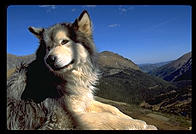 Towards the top of the park road, which goes up to 12,183', making it
the "highest continuous paved road in the US," I began to feel short
of breath and get a copper/salt taste in my mouth. A ranger at the
11,750' visitors' center said the metallic taste was a common symptom
of altitude, which reassured me.
Two Malamutes looked perfectly at
home at altitude and their owners turned out to be good souls from
Hewlett-Packard's Greeley scanner division. Two guys came over to
join the fun and when they heard us talking about exchanging JPEGs of
the dogs over Internet asked for the Travels with Samantha URL
because they were students at the Air Force Academy.
Towards the top of the park road, which goes up to 12,183', making it
the "highest continuous paved road in the US," I began to feel short
of breath and get a copper/salt taste in my mouth. A ranger at the
11,750' visitors' center said the metallic taste was a common symptom
of altitude, which reassured me.
Two Malamutes looked perfectly at
home at altitude and their owners turned out to be good souls from
Hewlett-Packard's Greeley scanner division. Two guys came over to
join the fun and when they heard us talking about exchanging JPEGs of
the dogs over Internet asked for the Travels with Samantha URL
because they were students at the Air Force Academy.
Driving in gathering darkness through narrow valleys, I knew that I
was really out of the park when I passed a Vishay sales office.
Hewlett-Packard is taking over Colorado and their Loveland division
apparently buys the fancy Vishay resistors. It was a very lonely and
trying trip on US 34 for an hour before I reached I-76, which punches
diagonially northeast from Denver into Nebraska. I collapsed at 11:30
in an interstate-side motel in Julesberg, Colorado, two miles short of
the border.
Monday, September 26, 1994
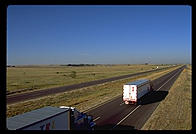 Crossing into Nebraska was thrilling out of all proportion to the flat
brown landscape. This was my first new state of the trip and 48th in
my life. Iowa and South Dakota were the only states I'd not visited.
Writing something interesting about Nebraska is a challenge. Doing it
when you cross the state on I-80 in ten hours is impossible. An
average farm started with a fine white farm house in the middle of an
acre of green lawn surrounded by square miles of corn. Iowa is
supposedly the state with the highest percentage of millionaires, but
Nebraska can't be far behind as I didn't notice too many people among
whom this agricultural wealth would have to be divided.
Crossing into Nebraska was thrilling out of all proportion to the flat
brown landscape. This was my first new state of the trip and 48th in
my life. Iowa and South Dakota were the only states I'd not visited.
Writing something interesting about Nebraska is a challenge. Doing it
when you cross the state on I-80 in ten hours is impossible. An
average farm started with a fine white farm house in the middle of an
acre of green lawn surrounded by square miles of corn. Iowa is
supposedly the state with the highest percentage of millionaires, but
Nebraska can't be far behind as I didn't notice too many people among
whom this agricultural wealth would have to be divided.
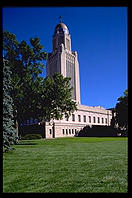 The
state capitol
in Lincoln is a fine Art Deco monument with a
14-story tower from the top of which Emil, a WalMart stock clerk,
proudly showed me the attractions available to the city's 200,000
residents. Emil was excited to be working in this Walmart which was
three times larger than the one he'd left in western Nebraska. The
governor and local press were coming to see their store's latest
innovation: whenever a mother lost a child in the store, an
announcement would come over the PA system that would cause every
employee to stop work and search for the kid. It sounded sensible,
but then I thought "this is Nebraska, what's going to happen to the
kid anyway?"
The
state capitol
in Lincoln is a fine Art Deco monument with a
14-story tower from the top of which Emil, a WalMart stock clerk,
proudly showed me the attractions available to the city's 200,000
residents. Emil was excited to be working in this Walmart which was
three times larger than the one he'd left in western Nebraska. The
governor and local press were coming to see their store's latest
innovation: whenever a mother lost a child in the store, an
announcement would come over the PA system that would cause every
employee to stop work and search for the kid. It sounded sensible,
but then I thought "this is Nebraska, what's going to happen to the
kid anyway?"
After dinner in the quaint yuppie Old Market section of Omaha, a vast
metropolis of 300,000 an hour east of Lincoln, I debated sticking
around town so that I could stalk pictures for
Heather has Two Mommies in the renowned Omaha Zoo.
Responsibility prevailed and I
charged across the Missouri River for a dark ride through suddenly
hilly Iowa. After the open spaces of New Mexico, dodging the heavy
semi traffic of I-80 at night made me pretty nervous, plus my
headlights seemed to be aimed too high and were irritating other
drivers. It was midnight when I checked into a Days Inn just west of
Iowa City. The desk clerk was a smoking kid from University of Iowa
who was taking a "using Internet" course. He was getting college
credit for reading
Travels with Samantha
on the Web! "Should I
lock the car?" I asked, "I've got a lot of cameras in it."
"This is Iowa. People don't steal things."
Tuesday, September 27
I crossed the Mississippi into Illinois in the "Quad Cities" area,
where chiropractic was invented and is still headquartered. The art
of highway maintenance that is so carefully practiced in Iowa and
Nebraska seems to have fallen into disrepute in Illinois. As the
moonscape of I-80 pounded my bones, I recalled an engineer from
Caterpillar who described his summer working for the Illinois
Department of Transportation.
"They worshipped the twin gods of Waste and Incompetence."
Anxious to get to the
Art Institute before closing time, I passed up
the Ronald Reagan Birthplace, 32 miles off the interstate. I needn't
have hurried. Tuesday is not only "free day" (though the others are
"pay what you can" like the Metropolitan) but "open until 8" day. I
wore out my feet and learned that the museum has a lot of good
pictures but no Vermeers.
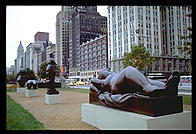 Despite my September interlude in Boston, I was overwhelmed by the big
city feel of Chicago after a summer in New Mexico. The scale of the
buildings, lakeshore park, lake, and traffic awed me. Every face
looked as if it betrayed an interesting story. It was
overstimulating, but not quite as nerve-wracking as navigating rush
hour Chicago traffic moving bumper to bumper at 65 mph in a minivan
with no rear visibility due to overpacking.
Despite my September interlude in Boston, I was overwhelmed by the big
city feel of Chicago after a summer in New Mexico. The scale of the
buildings, lakeshore park, lake, and traffic awed me. Every face
looked as if it betrayed an interesting story. It was
overstimulating, but not quite as nerve-wracking as navigating rush
hour Chicago traffic moving bumper to bumper at 65 mph in a minivan
with no rear visibility due to overpacking.
The mills of Gary, Indiana ringing the lakeshore just southeast of
Chicago looked truly Satanic. I wanted to stop for a picture but
couldn't figure out how so I pressed two hundred miles northeast on
I-94 into Ann Arbor, Michigan. For the first hour of my trip, I was
educated by Studs Terkel interviewing Roger G. Kennedy, the director
of the National Parks Service, and author of Hidden Cities, the
Discovery and Loss of Ancient North American Civilization. My
American history textbooks implied that, although the Aztecs and Incas
may have had impressive cultures, that the North American Indians had
never been more than nomads thinking about their next deer supper.
The truth is apparently that the Ohio river valley in the fourth
century A.D. was dotted with cities containing impressive earthworks
and hundreds of thousands of people. This was well-known to George
Washington and his contemporaries who evinced a genuine scientific
interest in these cities if not a respect for the descendants of the
city builders. When white Americans were engaged in a systematic
program of displacing the Indians, they didn't want to think of them
as having been capable of advanced civilization and hence the
knowledge was lost to laymen if not to historians. [Jeff and Lori
assured me later that if I watched public TV instead of the Simpsons,
I'd have learned about this long ago; Anne Marie assured me that if I
grew up near some of the big sites, such as Cahokia, Illinois, just
across the river from St. Louis, I'd also have known.]
Wednesday, September 28 (my 31st birthday)
Phil Donahue flung cheap shots at famous defense lawyers on the motel
breakfast room TV while I munched donuts. Neither Donahue nor his
audience approached the wit of one lawyer: "What's the difference
between a spermatozoa and a lawyer? The spermatozoa has a 1 in 6
million chance of becoming a human being."
University of Michigan has some nice Gothic architecture in addition
to the usual state university Bauhaus horrors. I sat for a moment in
the supremely comfortable and soul-inspiring student union reading the
daily paper. One photo that caught my MIT-trained eye was of the
school's new Star Trek club; it was of four attractive women.
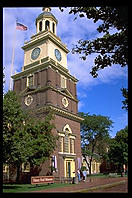 After my
year of litigation with Ford Motor Company, the city they'd
built in Dearborn drew me like a magnet. I skipped Henry Ford's
52-room limestone mansion and the various corporate campuses because I
wanted to concentrate on the Henry Ford
Museum
and Greenfield Village,
whose charms allegedly couldn't be fully explored in less than two days.
After my
year of litigation with Ford Motor Company, the city they'd
built in Dearborn drew me like a magnet. I skipped Henry Ford's
52-room limestone mansion and the various corporate campuses because I
wanted to concentrate on the Henry Ford
Museum
and Greenfield Village,
whose charms allegedly couldn't be fully explored in less than two days.
Henry Ford, who fought a libel suit over whether he said "History is
bunk," built a 12-acre replica of Philadelphia's Independence Hall to
house his treasured documents of American invention. The museum
opened in 1929 and resembles an airplane hanger inside.
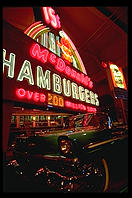 Don't look for Smithsonian-style explanations of technology; the
museum's credo is "We gots the
stuff and here it is." Edison's last
breath is in a test tube next to Abe Lincoln's death chair, not far
from the death car of John F. Kennedy, not far from an old McDonald's
sign, across the corridor from a silver collection, adjacent to a
bunch of vacuum cleaners, which are a stone's throw from a bunch of
old wooden farm machinery. Old people say that this is how the
Smithsonian was when everything was housed in the "castle" on the mall
and that it was better then. For them the Henry Ford Museum
represents the last authentic museum experience available in America.
Don't look for Smithsonian-style explanations of technology; the
museum's credo is "We gots the
stuff and here it is." Edison's last
breath is in a test tube next to Abe Lincoln's death chair, not far
from the death car of John F. Kennedy, not far from an old McDonald's
sign, across the corridor from a silver collection, adjacent to a
bunch of vacuum cleaners, which are a stone's throw from a bunch of
old wooden farm machinery. Old people say that this is how the
Smithsonian was when everything was housed in the "castle" on the mall
and that it was better then. For them the Henry Ford Museum
represents the last authentic museum experience available in America.
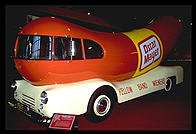 Irene, a museum staffer, two retired ladies from Oklahoma, and I
paused for a conversation. Surrounded as we were by the greatest
American inventions of the past century, we naturally discussed....
O.J. Simpson.
Irene, a museum staffer, two retired ladies from Oklahoma, and I
paused for a conversation. Surrounded as we were by the greatest
American inventions of the past century, we naturally discussed....
O.J. Simpson.
"Do you think he's guilty?" Irene asked.
"I've been living in a tent all summer with no TV. I'm not educated enough to say," I responded.
The two Oklahoma ladies remarked that it was amazing how many people
thought that he wasn't guilty or that, if he was, he shouldn't go to
jail. They'd never met any of these people, but they'd heard reports
that they existed.
Irene nodded her head but I decided to stir up the pot with a slightly
stretched argument from David Hume.
"Why do you think that everyone shares the belief that justice is
good? For example, if we had a society of superabundance,
property-based laws and courts would serve no purpose. Would there be
any point in prosecuting someone for stealing your car when you could
just as easily walk down to the corner and get another one for free?"
My listeners looked slightly puzzled but I pressed on.
"What if we had a society with resources so limited that you couldn't
get enough to feed your family no matter how hard you worked unless
you stole. People in that society wouldn't think property laws and
courts were useful either. It is only in a middle-class society where
folks believe that reasonably hard work will yield a reasonable
standard of living that justice is considered good. If the TV
networks find a black guy in the ghetto who believes, whether or not
it is true, that there is no honest way for him to get ahead in this
world, there is no reason to suppose that he'd buy into our
middle-class concept of justice. Admittedly O.J.'s crime was a crime
of passion, not of property, but once you get the ideas that courts
and laws aren't serving your community, you probably don't think they
are useful for anything."
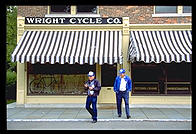 Greenfield Village
is a 120-acre confection of Americana, albeit an
extremely inventive and litigious Americana. Henry Ford liked certain
buildings all around the country, especially the homes of inventors
and self-made men of industry. He wasn't content to take snapshots;
he physically dragged the buildings here. Thomas Edison's complete
Menlo Park laboratory is here. The chemical-stained bleary-eyed
workers are gone, but old women relate with pride how he got 1093
patents.
Greenfield Village
is a 120-acre confection of Americana, albeit an
extremely inventive and litigious Americana. Henry Ford liked certain
buildings all around the country, especially the homes of inventors
and self-made men of industry. He wasn't content to take snapshots;
he physically dragged the buildings here. Thomas Edison's complete
Menlo Park laboratory is here. The chemical-stained bleary-eyed
workers are gone, but old women relate with pride how he got 1093
patents.
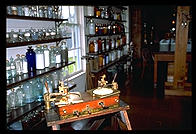 "If any of the workers got sick, Edison would mix up a cocktail of
chemicals at that bench over there and make them well. They were all
working so hard that they couldn't afford to have anyone sick, you
see."
"If any of the workers got sick, Edison would mix up a cocktail of
chemicals at that bench over there and make them well. They were all
working so hard that they couldn't afford to have anyone sick, you
see."
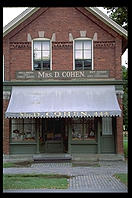 Edison was Ford's hero, you see, and the whole place was dedicated to
Edison in person when it opened in 1929 (Edison was 82 at the time).
The Wright Brothers weren't far behind and get two spots: one for the
bike shop/workshop and one for their home. Ford was no racist and
Booker T. Washington's house is here to prove it. Nor did his
reputation for Jew-hatred seem warranted standing in front of Mrs. D.
Cohen's perfectly preserved millinery shop.
Edison was Ford's hero, you see, and the whole place was dedicated to
Edison in person when it opened in 1929 (Edison was 82 at the time).
The Wright Brothers weren't far behind and get two spots: one for the
bike shop/workshop and one for their home. Ford was no racist and
Booker T. Washington's house is here to prove it. Nor did his
reputation for Jew-hatred seem warranted standing in front of Mrs. D.
Cohen's perfectly preserved millinery shop.
 A whimsical mood prevails in Greenfield Village. A lovely Stephen
Foster memorial fronts the circular pond with working steamboat.
Model T Fords cruise the streets, a steam train circles the complex,
and children ride a wooden carousel. Nothing American would be
complete without various ripped-off parts of Europe, of course, and
Henry Ford wasn't content to replicate a la Busch Gardens. Parts of
the Cotswolds and Switzerland were excised and rest here.
A whimsical mood prevails in Greenfield Village. A lovely Stephen
Foster memorial fronts the circular pond with working steamboat.
Model T Fords cruise the streets, a steam train circles the complex,
and children ride a wooden carousel. Nothing American would be
complete without various ripped-off parts of Europe, of course, and
Henry Ford wasn't content to replicate a la Busch Gardens. Parts of
the Cotswolds and Switzerland were excised and rest here.
Although the $20 combined ticket price isn't very different from
Disneyland's, the corporate stage management and heavy-handed spin
control is absent. The bookshop contains a full selection of
biographies of Ford and none of them gloss over Ford's worldwide
publication of anti-Jewish propaganda from 1921 through 1927, when he
retracted his views, and continuing much later in Germany and many
other foreign countries. The continued popularity and availability of
Ford's work in the 1930's in Germany, Ford's acceptance in 1938 of
Germany's highest honor from Adolph Hitler, and Ford's refusal to
reaffirm his 1927 retraction clouded his reputation further. However,
at the end of the war, Ford began to see and state that he'd been
mistaken about the International Jew and noted that he should figure
out how Hitler and Germany had managed to cause so much trouble. Ford
only had two more years to live so it languished on his "to do" list.
I didn't feel inclined to judge Ford harshly. On the witness stand in
the "history is bunk" trial, he proved embarrassingly ignorant of
history. He seems to have been nice to all the Jews he knew
personally and appears to have refused to finance Hitler despite
rumors to the contrary. It is a tragedy of capitalism that the
ill-informed opinions of the rich assume titantic and profound
proportions in the public mind. We automatically assume that poor
people must be stupid--otherwise why wouldn't we just give them money
instead of social workers, Medicaid, food stamps, etc.--and that rich
people must have done something wonderfully innovative and clever to
get that way.
As the museum closed at 5 pm, I headed through Detroit's mellow rush
hour towards Canada. A gas station attendant warned me to "watch out
for those Canadian drivers." I took his advice seriously, reasoning
that anyone who chose to live in the traditional Murder Capital of the
US was probably not easily alarmed.
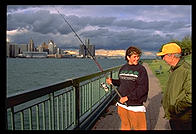
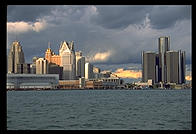
My first stop in Canada was the sister city of Windsor, Ontario, where
I photographed the Detroit skyline from the riverfront and chatted
with Leonard, who was fishing, and Candis, his 8th-grader friend. The
metric system doesn't seem to be taking root in Ontario because Candis
said she was more comfortable thinking in pounds than kilograms.
 Lower Ontario seems like a flatter version of Iowa: cornfields and
smooth highway. Without federal subsidies, however, the farmhouses
were functional rather than palatial and never surrounded by huge
expanses of lawn. Every acre was put to some use and millionaires
appeared to be thin on the ground.
Lower Ontario seems like a flatter version of Iowa: cornfields and
smooth highway. Without federal subsidies, however, the farmhouses
were functional rather than palatial and never surrounded by huge
expanses of lawn. Every acre was put to some use and millionaires
appeared to be thin on the ground.
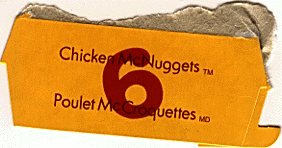 Stoked with Poulet McCroquettes from McDonald's, I made it all the way
to Niagara Falls by 11 pm. I remembered being awed by the Falls when
I was 10 on the Great Family Trip to Upstate New York (complete with
sister screaming in the back seat). I had never seen anything on that
scale before. After traveling in the West, Alaska, and New Zealand,
however, the Falls don't seem unbelievable outsized anymore even if
the sheer amount of water staggers the New Mexican mind.
Stoked with Poulet McCroquettes from McDonald's, I made it all the way
to Niagara Falls by 11 pm. I remembered being awed by the Falls when
I was 10 on the Great Family Trip to Upstate New York (complete with
sister screaming in the back seat). I had never seen anything on that
scale before. After traveling in the West, Alaska, and New Zealand,
however, the Falls don't seem unbelievable outsized anymore even if
the sheer amount of water staggers the New Mexican mind.
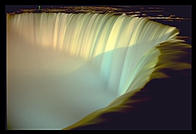 They'd turned off the lights on the Falls at 11 pm so I shuddered in
the darkness at the lip of the more graceful Canadian Horseshoe Falls
before returning to the solid neon of the tourist streets. The
Canadian side is famously less tacky than the American side, so seeing
wax museums every few meters, a Ripley's Believe it or Not museum, a
Guinness Book of World Records museum, every kind of carnival game and
booth, I shuddered to think what the American side would be like.
They'd turned off the lights on the Falls at 11 pm so I shuddered in
the darkness at the lip of the more graceful Canadian Horseshoe Falls
before returning to the solid neon of the tourist streets. The
Canadian side is famously less tacky than the American side, so seeing
wax museums every few meters, a Ripley's Believe it or Not museum, a
Guinness Book of World Records museum, every kind of carnival game and
booth, I shuddered to think what the American side would be like.
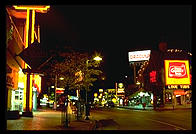
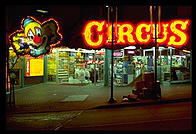 Thursday, September 29, 1994
Thursday, September 29, 1994
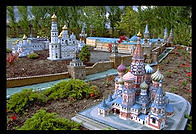 Tivoli Miniature World
was my favorite tourist attraction in Niagara Falls. Where else can
you get the Taj Mahal, Arc de Triomphe, and Eiffel Tower all in one
picture with the 600'-high Skylon Tower in the background. Models of
medieval cities and cathedrals are exquisitely detailed and precise.
I even saw Mt. Rushmore, which I'd scratched with regret from my
touring program despite the fact that it would have made a perfect 50
states.
Tivoli Miniature World
was my favorite tourist attraction in Niagara Falls. Where else can
you get the Taj Mahal, Arc de Triomphe, and Eiffel Tower all in one
picture with the 600'-high Skylon Tower in the background. Models of
medieval cities and cathedrals are exquisitely detailed and precise.
I even saw Mt. Rushmore, which I'd scratched with regret from my
touring program despite the fact that it would have made a perfect 50
states.
Determined to make the Falls look as small as Tivoli Miniature World,
I hopped into one of Niagara Helicopters's Bell Jet Rangers for a
bird's eye view of the city, gorge, power project, and Falls. This
was living.
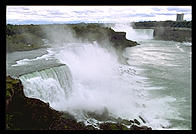
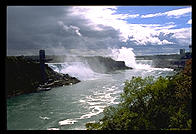
I drove back into the US and straight along the shore of Lake Ontario
past tidy corn, apple, pear, and berry farms. It was painful to go
through Rochester without stopping at any of the Eastman-funded
monuments to photography, but I was anxious to get to Oswego, a couple
of hours east.
Oswego, New York is a dream town for any public relations person
looking for a challenge. The town contains three nuclear power plants
and a concentration camp for Jews.
Friday, September 30, 1994
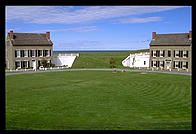 Fort Ontario's earthen walls sit on high ground above the mouth of the
Oswego River and Lake Ontario. It is a New York State Historic Site
that is being restored to its 1868 appearance. I barged in on Patrick
Wilder and Richard Lacrosse, Jr., the two on-site historians, and
asked about the fort's World War II history.
Fort Ontario's earthen walls sit on high ground above the mouth of the
Oswego River and Lake Ontario. It is a New York State Historic Site
that is being restored to its 1868 appearance. I barged in on Patrick
Wilder and Richard Lacrosse, Jr., the two on-site historians, and
asked about the fort's World War II history.
"We can tell you about that," Patrick said, "but the fort's most
interesting history was during the Revolutionary War and the War of
1812. Fort Ontario was the embarkation point for the world's first
boat people. Did you ever wonder where the English speakers of Canada
came from? `British North America', as it was then called, was just
French settlers and Indians until the Revolutionary War. During the
war, loyalists from all over the 13 colonies came to Fort Ontario,
which was held by the British, and embarked across the Lake to British
North America.
Fort Ontario isn't too far from the Proclamation Line, which was one
of the causes of both the Revolutionary War and the War of 1812. The
British gave the Indians jurisdiction to the west of the line and the
white settlers jurisdiction to the east. A fellow like George
Washington who'd already claimed 500,000 acres in Ohio couldn't be
expected to be very happy with this arrangement. People forget that
there were revolts not just in the 13 colonies but in the Caribbean as
well and that the goals of the Revolutionary War included establishing
a country that was much larger, including Canada, Bermuda, and the
Bahamas. The settlement of 1783 that ended the war was brokered by
the French.
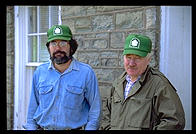 They told the Americans that the most they could hope to get was the
13 colonies and that promising to honor the Proclamation Line and
compensate the loyalists for their homes wasn't so bad, that they
could possibly gain some of the other goals in the future. So the
Americans signed.
They told the Americans that the most they could hope to get was the
13 colonies and that promising to honor the Proclamation Line and
compensate the loyalists for their homes wasn't so bad, that they
could possibly gain some of the other goals in the future. So the
Americans signed.
Between the Revolutionary War and the War of 1812, the population of
the U.S. went from three million to over seven million. That wasn't
from immigration and it was mostly in the northeast. What happened is
that men in the northeast had four or five wives and twenty children.
They'd go through wives the way you'd go through oxen. When one got
worn out and died in childbirth, they'd get another. The oldest son
would get the farm and the rest of the kids would move out to the Ohio
river valley and clear some of the forest the Indians were intent on
preserving. When the Indians would kill one of these guys, his
relatives back in Massachusetts would complain to their Congressmen
and they would pressure the president to send in troops. This caused
the Indians and the British to complain that the US wasn't honoring
the 1783 agreement or the 1796 agreement, which finally ended British
control of forts such as Fort Ontario. In return, the Americans
reiterated their promise to honor the Proclamation Line, which they
didn't, and compensate the loyalists, which they didn't.
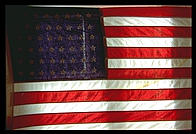 Meanwhile, the British were at war with Napoleon. When the Royal Navy
needed a merchant vessel, they'd grab one from the English merchant
marine and pay the owner a fixed sum. The owners didn't like that so
they would reflag their vessels in the US and claim that the ship
could no longer be appropriated because it was American. And what do
you think would happen if a Royal Navy ship pulled into a port next to
an American merchant ship? The sailors on the British ship were
poorly paid, poorly fed, got shot at, and often received the cat o'
nine tails. They'd see the well-fed, well-paid, happy American
sailors on the neighboring ship. There would be a couple of splashes
in the middle of the night and the American ship would have a couple
of new crewmembers.
Meanwhile, the British were at war with Napoleon. When the Royal Navy
needed a merchant vessel, they'd grab one from the English merchant
marine and pay the owner a fixed sum. The owners didn't like that so
they would reflag their vessels in the US and claim that the ship
could no longer be appropriated because it was American. And what do
you think would happen if a Royal Navy ship pulled into a port next to
an American merchant ship? The sailors on the British ship were
poorly paid, poorly fed, got shot at, and often received the cat o'
nine tails. They'd see the well-fed, well-paid, happy American
sailors on the neighboring ship. There would be a couple of splashes
in the middle of the night and the American ship would have a couple
of new crewmembers.
The British didn't like to see their merchant fleet or their navy
shrink so they took to stopping ships on the high seas and looking
around to see if the men or ship had previously been British. If so,
they'd seize the ship and the men and sometimes even hang a few navy
deserters. One time, they even boarded an American warship and took
off a few deserters and when word got to the newspapers, Americans
everywhere were humiliated and outraged.
The war started, though, when the French encouraged the Americans to
take Canada and renounce their agreement regarding the Proclamation
Line. The US expected it to be easy because they figured the French
up there would welcome liberation from English rule.
Well, we lost. It was our first Vietnam.
The French in British North America didn't want to be part of the U.S.
The British let them keep their law, elect their local politicians,
and practice Catholicism. Many of the New England states had
established Protestant churches at the time."
"Oh yes," I recalled, "I think Massachusetts had a state church until 1820."
"That's right, plus they ran into 10,000 British troops. You won't
read about the attempt to take Canada in history books, though,
because we lost those battles. One of the nice things about not being
occupied after a defeat is that you get to write your own history of
the war.... Of course, the Germans and Japanese were occupied and
they've been doing it anyway... Well, if you look at an American
history textbook, what you'll mostly read about is a naval battle in
New Orleans. It was irrelevant to the main currents of the war and we
mostly won because of luck and the fortunes of war, but we won so you
get two pages on it. Nobody mentions that none of the war's
objectives were achieved and that we actually lost some territory.
Anyway, these are the kind of stories that the loyalists who fled to
Canada have been passing down through the generations up there and you
don't have to push a conversation very far over there before you dig
up a different look at the American Revolution."
Most of what I'd thought about the fort's role in World War II turned
out to be wrong as well. A little background may be helpful first.
Although numerous European governments on both sides of the conflict
appealed to the U.S. to shelter some Jews from the Holocaust, FDR was
adamant about not letting a single Jew become an American citizen
throughout the war and he was also adamantly opposed to temporarily
sheltering any refugees. However, by 1944 pressure from countries
such as England had become so intense that FDR felt he had to make at
least a token gesture. Consequently, it was decided to accept one
boatload of refugees.
I'd thought that these 982 people, most of them Jews, were saved from
the Holocaust. However, I learned from Patrick that they'd already
escaped the death camps and were residing in liberated Italy. Thus,
the U.S. was really doing the Italians a favor by taking 982 mouths to
feed off their hands.
Roosevelt wanted to make sure that these folks never became permanent
U.S. residents and imprisoned them in Fort Ontario behind barbed wire.
I thought that he'd succeeded and that they were eventually deported.
However, I learned that the imprisonment wasn't comprehensive during
the war, for school-age children were let out during the day to attend
Oswego Public Schools, and I also learned that FDR's plan was
thwarted.
Congress was also opposed to letting the refugees stay, but Harry
Truman felt sorry for them. In 1946, when Congress was in recess,
Truman unilaterallly ordered all 982 across the border into Canada for
a day and then readmitted to the U.S. by special presidential order;
899 ultimately settled permanently in the U.S. and 50 or 60 returned
recently for the 50th anniversary of the Fort Ontario camp.
Several excellent books have been written on the subject:
Haven:
The Unkown Story of 1000 WWII Refugees by Dr. Ruth Gruber, the
former liaison between the refugees and the government, Token
Refuge, by Sharon Lowenstein, and
Don't Fence Me In, by
Joseph Smart, the former commander of the camp.
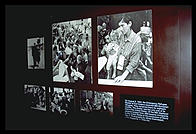 I walked around the fort with my camera, but was disappointed to find
that none of the buildings from the refugee camp remain. They were
torn down by the city and state after the federal government turned
the land over to them in 1946. The fort itself is being restored to
its 1868 appearance and the whole park is going to concentrate on this
particularly uneventful period of the fort's history. Exhibits and
information that don't relate to this period will be torn down.
I walked around the fort with my camera, but was disappointed to find
that none of the buildings from the refugee camp remain. They were
torn down by the city and state after the federal government turned
the land over to them in 1946. The fort itself is being restored to
its 1868 appearance and the whole park is going to concentrate on this
particularly uneventful period of the fort's history. Exhibits and
information that don't relate to this period will be torn down.
Today's museum has a very informative well-designed
artistically-presented series of exhibits on the fort's history from
1726 through WWII. All the exhibits are professional with a unified
graphic design, except for the one wall given over to the refugee camp
days. This looks like an afterthought and basically consists of a
bunch of photographs tacked to the wall.
One of the saddest wall hangings is an engraving showing the town of
Oswego in 1852. It looks beautiful and bustling with tall ships at
every dock and graceful buildings at the mouth of the Oswego River.
Today, there are ugly docks and oil storage tanks where the tall ships
once berthed.
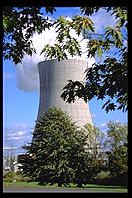 Before leaving town, I headed out to the nuclear electricity plant
complex. The first two reactors are cooled with lake water and look
like generic factories. The third and last was built with a
characteristic cooling tower because people were concerned about heat
build-up in the bay.
Before leaving town, I headed out to the nuclear electricity plant
complex. The first two reactors are cooled with lake water and look
like generic factories. The third and last was built with a
characteristic cooling tower because people were concerned about heat
build-up in the bay.
A nice Energy Center explains the wonders of the reactors, how safe
nuclear energy is, and how one eighth of New York State's power is
generated here. Three Mile Island isn't mentioned in the
exhibits.
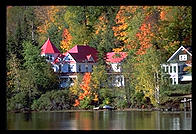 I left Oswego at 3 pm and threaded my way around the east shore of
Lake Ontario and then east into the Adirondacks to Saranac Lake. The
Adirondacks that you can see from the road have a much more settled
look than the White Mountains. There are large areas of
near-wilderness, but one has to get far off the main roads to see
them. Still the foliage was marvelous.
I left Oswego at 3 pm and threaded my way around the east shore of
Lake Ontario and then east into the Adirondacks to Saranac Lake. The
Adirondacks that you can see from the road have a much more settled
look than the White Mountains. There are large areas of
near-wilderness, but one has to get far off the main roads to see
them. Still the foliage was marvelous.
Saturday, October 1
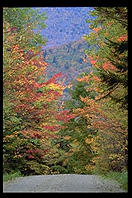 Driving back to Boston through the Adirondacks and southern Vermont in
foliage season may not be heaven, but as a homecoming technique it
sure beats driving up the Jersey Turnpike in the rain after having all
of one's posessions stolen in Filthadelphia (see
Travels with
Samantha, Chapter XVII).
Driving back to Boston through the Adirondacks and southern Vermont in
foliage season may not be heaven, but as a homecoming technique it
sure beats driving up the Jersey Turnpike in the rain after having all
of one's posessions stolen in Filthadelphia (see
Travels with
Samantha, Chapter XVII).
 Foliage Pictures
Foliage Pictures
The Adirondacks began to grow on me on Route 73 southeast of Lake
Placid. This was the highest and wildest part of the part so far,
under a blue sky with wispy clouds. At Ft. Ticonderoga, I took a
ferry across Lake Champlain then continued on 73 to 100, the spine of
the Green Mountains. After photographing Moss Glen Falls and Texas
Falls, I stopped for an excellent lunch at the Rochester Cafe in
Rochester. Despite some very interesting conversations with
Vermonters who'd given up the city because they didn't like the pace
and the imposed value system in which things not done to earn a buck
are considered a waste, I regretted stopping. My leisurely lunch
caused me to arrive in Quechee 15 minutes after the last launch of the
day in the Quechee Balloon Festival, which I had completely forgotten
about.
I wish I could say that something really interesting happened in the
last moments of the trip but I-89 and I-93 down to Boston in the dark
are not the places for epiphanies.
The End.
Shameless Advertising
If you've read this far, you might enjoy my other Web books:
 Up to the Footsteps cover page.
Up to the Footsteps cover page.
Related Links
philg@mit.edu
Add a comment | Add a link
 I was just getting to really like Los Alamos. I'd met the town
intellectuals and had two or three dinner dates a week and a lunch
date every day if I could tear myself away from my beloved Macintosh
Common Lisp. Weekends with Susie and Stephen in Santa Fe, with its
string of Friday night art gallery openings and super deluxe art
market kept me sane. However, it was getting cold in my tent and I
decided that LANL was a better place to finish a computer science PhD
thesis than to start one. I started driving back towards MIT.
I was just getting to really like Los Alamos. I'd met the town
intellectuals and had two or three dinner dates a week and a lunch
date every day if I could tear myself away from my beloved Macintosh
Common Lisp. Weekends with Susie and Stephen in Santa Fe, with its
string of Friday night art gallery openings and super deluxe art
market kept me sane. However, it was getting cold in my tent and I
decided that LANL was a better place to finish a computer science PhD
thesis than to start one. I started driving back towards MIT. 

























 Stoked with Poulet McCroquettes from McDonald's, I made it all the way
to Niagara Falls by 11 pm. I remembered being awed by the Falls when
I was 10 on the Great Family Trip to Upstate New York (complete with
sister screaming in the back seat). I had never seen anything on that
scale before. After traveling in the West, Alaska, and New Zealand,
however, the Falls don't seem unbelievable outsized anymore even if
the sheer amount of water staggers the New Mexican mind.
Stoked with Poulet McCroquettes from McDonald's, I made it all the way
to Niagara Falls by 11 pm. I remembered being awed by the Falls when
I was 10 on the Great Family Trip to Upstate New York (complete with
sister screaming in the back seat). I had never seen anything on that
scale before. After traveling in the West, Alaska, and New Zealand,
however, the Falls don't seem unbelievable outsized anymore even if
the sheer amount of water staggers the New Mexican mind. 











